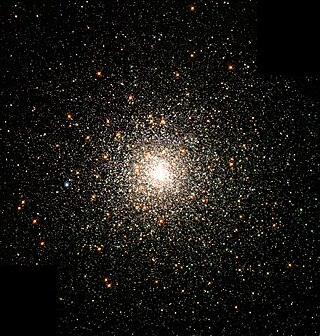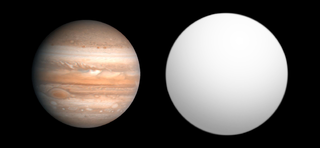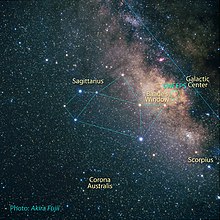
A globular cluster is a spheroidal conglomeration of stars. Globular clusters are bound together by gravity, with a higher concentration of stars towards their centers. They can contain anywhere from tens of thousands to many millions of member stars. Their name is derived from Latin globulus. Globular clusters are occasionally known simply as "globulars".

Spiral galaxies form a class of galaxy originally described by Edwin Hubble in his 1936 work The Realm of the Nebulae and, as such, form part of the Hubble sequence. Most spiral galaxies consist of a flat, rotating disk containing stars, gas and dust, and a central concentration of stars known as the bulge. These are often surrounded by a much fainter halo of stars, many of which reside in globular clusters.

A supermassive black hole is the largest type of black hole, with its mass being on the order of hundreds of thousands, or millions to billions of times the mass of the Sun (M☉). Black holes are a class of astronomical objects that have undergone gravitational collapse, leaving behind spheroidal regions of space from which nothing can escape, not even light. Observational evidence indicates that almost every large galaxy has a supermassive black hole at its center. For example, the Milky Way has a supermassive black hole in its Galactic Center, corresponding to the radio source Sagittarius A*. Accretion of interstellar gas onto supermassive black holes is the process responsible for powering active galactic nuclei (AGNs) and quasars.

The Galactic Center or Galactic Centre is the rotational center, the barycenter, of the Milky Way galaxy. Its central massive object is a supermassive black hole of about 4 million solar masses, which is called Sagittarius A*, a compact radio source which is almost exactly at the galactic rotational center. The Galactic Center is approximately 8 kiloparsecs (26,000 ly) away from Earth in the direction of the constellations Sagittarius, Ophiuchus, and Scorpius, where the Milky Way appears brightest, visually close to the Butterfly Cluster (M6) or the star Shaula, south to the Pipe Nebula.

In astronomy, a galactic bulge is a tightly packed group of stars within a larger star formation. The term almost exclusively refers to the central group of stars found in most spiral galaxies. Bulges were historically thought to be elliptical galaxies that happened to have a disk of stars around them, but high-resolution images using the Hubble Space Telescope have revealed that many bulges lie at the heart of a spiral galaxy. It is now thought that there are at least two types of bulges: bulges that are like ellipticals and bulges that are like spiral galaxies.

The Sagittarius Dwarf Spheroidal Galaxy (Sgr dSph), also known as the Sagittarius Dwarf Elliptical Galaxy, is an elliptical loop-shaped satellite galaxy of the Milky Way. It contains four globular clusters in its main body, with the brightest of them – NGC 6715 (M54) – being known well before the discovery of the galaxy itself in 1994. Sgr dSph is roughly 10,000 light-years in diameter, and is currently about 70,000 light-years from Earth, travelling in a polar orbit at a distance of about 50,000 light-years from the core of the Milky Way. In its looping, spiraling path, it has passed through the plane of the Milky Way several times in the past. In 2018 the Gaia project of the European Space Agency showed that Sgr dSph had caused perturbations in a set of stars near the Milky Way's core, causing unexpected rippling movements of the stars triggered when it moved past the Milky Way between 300 and 900 million years ago.
HD 169830 is a star in the southern constellation of Sagittarius. It has a yellow-white hue and is dimly visible to the naked eye with an apparent visual magnitude of +5.90. The star is located at a distance of 120 light years from the Sun based on parallax. It is drifting closer with a radial velocity of −17.3 km/s, and is predicted to come as close as 20.7 ly (6.4 pc) in 2.08 million years. HD 169830 is known to be orbited by two large Jupiter-like exoplanets.

The Milky Way is the galaxy that includes the Solar System, with the name describing the galaxy's appearance from Earth: a hazy band of light seen in the night sky formed from stars that cannot be individually distinguished by the naked eye. The term Milky Way is a translation of the Latin via lactea, from the Greek γαλακτικὸς κύκλος, meaning "milky circle". From Earth, the Milky Way appears as a band because its disk-shaped structure is viewed from within. Galileo Galilei first resolved the band of light into individual stars with his telescope in 1610. Until the early 1920s, most astronomers thought that the Milky Way contained all the stars in the Universe. Following the 1920 Great Debate between the astronomers Harlow Shapley and Heber Doust Curtis, observations by Edwin Hubble showed that the Milky Way is just one of many galaxies.
HD 38529 is a binary star approximately 138 light-years away in the constellation of Orion.

OGLE-2005-BLG-390L is a star thought to be a spectral type M. This dim magnitude 16 galactic bulge star is located in the Scorpius constellation at a far distance of about 21,500 light years.

The Optical Gravitational Lensing Experiment (OGLE) is a Polish astronomical project based at the University of Warsaw that runs a long-term variability sky survey (1992–present). The main goals are the detection and classification of variable stars, discovery of microlensing events, dwarf novae, and studies of the structure of the Galaxy and the Magellanic Clouds. Since the project began in 1992, it has discovered a multitude of extrasolar planets, together with the first planet discovered using the transit method (OGLE-TR-56b) and gravitational microlensing. The project has been led by professor Andrzej Udalski since its inception.
OGLE-TR-56 is a dim, distant, magnitude 17 Sun-like star located approximately 1,500 parsecs away in the constellation of Sagittarius. This star is listed as an eclipsing type variable star with the eclipse due to the passage of the planet as noted in the discovery papers.
MACHO-1997-BLG-41, commonly abbreviated as 97-BLG-41 or MACHO-97-BLG-41, was a gravitational microlensing event located in Sagittarius which occurred in July 1999. The source star is likely a giant or subgiant star of spectral type K located at a distance of around 8 kiloparsecs. The lens star is a binary system approximately 10,000 light-years away in the constellation Sagittarius. The two stars are separated from each other by about 0.9 AU and have an orbital period of around 1.5 years. The most likely mass of the system is about 0.3 times that of the Sun. Star A and star B are both red dwarfs.

Baade's Window is an area of the sky with relatively low amounts of interstellar dust along the line of sight from Earth. This area is considered an observational "window" as the normally obscured Galactic Center of the Milky Way is visible in this direction. This makes the apparent Large Sagittarius Star Cloud visible.

SWEEPS-10 is an extrasolar planet that, from June 2007 to August 2011, was the planet candidate with the shortest orbital period yet found, until PSR J1719-1438 b was discovered in 2011 with an even shorter orbit. The planet orbits the star SWEEPS J175902.00−291323.7 located in the Galactic bulge at a distance of approximately 22,000 light years from Earth.

SWEEPS-04 is an extrasolar planet orbiting the star SWEEPS J175853.92−291120.6 in the constellation Sagittarius approximately 27,710 light years away from the Solar System, making it the most distant exoplanet(s) known. This planet was found in 2006 by the Sagittarius Window Eclipsing Extrasolar Planet Search (SWEEPS) program that uses the transit method.

SWEEPS-11 is an extrasolar planet orbiting the star SWEEPS J175902.67−291153.5 in the constellation Sagittarius, approximately 27,710 light years away from the Solar System, making it the most distant exoplanet(s) known. This planet was found in 2006 by the Sagittarius Window Eclipsing Extrasolar Planet Search (SWEEPS) program that uses the transit method.
An extragalactic planet, also known as an extragalactic exoplanet or an extroplanet, is a star-bound planet or rogue planet located outside of the Milky Way Galaxy. Due to the immense distances to such worlds, they would be very hard to detect directly. However, indirect evidence suggests that such planets exist. Nonetheless, the most distant known planets are SWEEPS-11 and SWEEPS-04, located in Sagittarius, approximately 27,710 light-years from the Sun, while the Milky Way is between 100,000 and 180,000 light years in diameter. This means that even galactic planets located farther than that distance have not been detected.

SWEEPS J175853.92-291120.6 is a star located in the constellation Sagittarius at a distance of 27,700 light-years from Earth. At least one planet, SWEEPS-04, is known to orbit the star.

The Large Sagittarius Star Cloud is the brightest visible region of the Milky Way galaxy, a portion of the central bulge seen around the thick dust of the Great Rift which lines the northwest edge. It should not be confused with the nearby Small Sagittarius Star Cloud, which lies about 10° to the north. The star cloud stretches several degrees north from the star Gamma Sagittarii and is considered a splendid sight in binoculars - "a bright glow with multitudes of momentarily resolved star-sparks". To the naked eye, the Cloud appears bright and smooth, and is said to resemble a puff of "steam" escaping from the spout of the Sagittarius "Teapot" asterism.





















